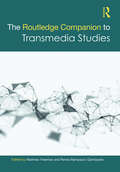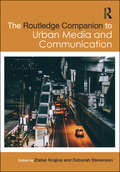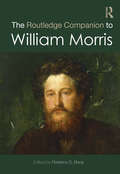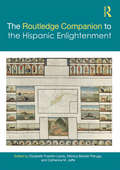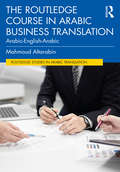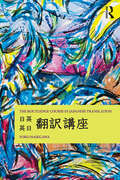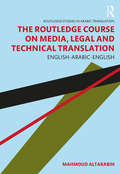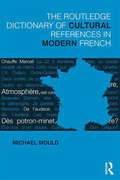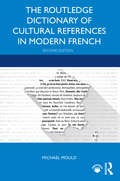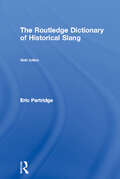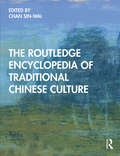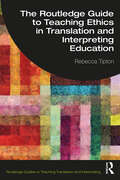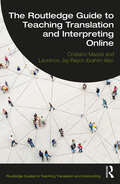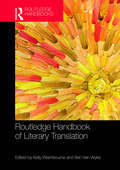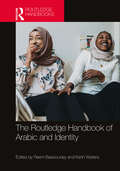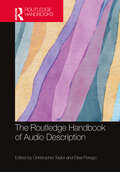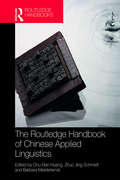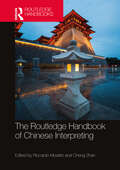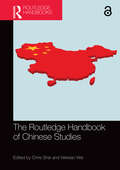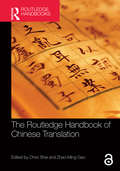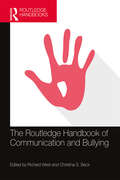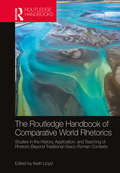- Table View
- List View
The Routledge Companion to Transmedia Studies (Routledge Media and Cultural Studies Companions)
by Matthew Freeman Renira Rampazzo GambaratoAround the globe, people now engage with media content across multiple platforms, following stories, characters, worlds, brands and other information across a spectrum of media channels. This transmedia phenomenon has led to the burgeoning of transmedia studies in media, cultural studies and communication departments across the academy. The Routledge Companion to Transmedia Studies is the definitive volume for scholars and students interested in comprehending all the various aspects of transmediality. This collection, which gathers together original articles by a global roster of contributors from a variety of disciplines, sets out to contextualize, problematize and scrutinize the current status and future directions of transmediality, exploring the industries, arts, practices, cultures, and methodologies of studying convergent media across multiple platforms.
The Routledge Companion to Urban Media and Communication
by Deborah Stevenson Zlatan KrajinaThe Routledge Companion to Urban Media and Communication traces central debates within the burgeoning interdisciplinary research on mediated cities and urban communication. The volume brings together diverse perspectives and global case studies to map key areas of research within media, cultural and urban studies, where a joint focus on communications and cities has made important innovations in how we understand urban space, technology, identity and community. Exploring the rise and growing complexity of urban media and communication as the next key theme for both urban and media studies, the book gathers and reviews fast-developing knowledge on specific emergent phenomena such as: reading the city as symbol and text; understanding urban infrastructures as media (and vice-versa); the rise of global cities; urban and suburban media cultures: newspapers, cinema, radio, television and the mobile phone; changing spaces and practices of urban consumption; the mediation of the neighbourhood, community and diaspora; the centrality of culture to urban regeneration; communicative responses to urban crises such as racism, poverty and pollution; the role of street art in the negotiation of ‘the right to the city’; city competition and urban branding; outdoor advertising; moving image architecture; ‘smart’/cyber urbanism; the emergence of Media City production spaces and clusters. Charting key debates and neglected connections between cities and media, this book challenges what we know about contemporary urban living and introduces innovative frameworks for understanding cities, media and their futures. As such, it will be an essential resource for students and scholars of media and communication studies, urban communication, urban sociology, urban planning and design, architecture, visual cultures, urban geography, art history, politics, cultural studies, anthropology and cultural policy studies, as well as those working with governmental agencies, cultural foundations and institutes, and policy think tanks.
The Routledge Companion to William Morris (Routledge Art History and Visual Studies Companions)
by Florence S. BoosWilliam Morris (1834–96) was an English poet, decorative artist, translator, romance writer, book designer, preservationist, socialist theorist, and political activist, whose admirers have been drawn to the sheer intensity of his artistic endeavors and efforts to live up to radical ideals of social justice. This Companion draws together historical and critical responses to the impressive range of Morris’s multi-faceted life and activities: his homes, travels, family, business practices, decorative artwork, poetry, fantasy romances, translations, political activism, eco-socialism, and book collecting and design. Each chapter provides valuable historical and literary background information, reviews relevant opinions on its subject from the late-nineteenth century to the present, and offers new approaches to important aspects of its topic. Morris’s eclectic methodology and the perennial relevance of his insights and practice make this an essential handbook for those interested in art history, poetry, translation, literature, book design, environmentalism, political activism, and Victorian and utopian studies.
The Routledge Companion to William Morris (Routledge Art History and Visual Studies Companions)
by Florence S. BoosWilliam Morris (1834–96) was an English poet, decorative artist, translator, romance writer, book designer, preservationist, socialist theorist, and political activist, whose admirers have been drawn to the sheer intensity of his artistic endeavors and efforts to live up to radical ideals of social justice. This Companion draws together historical and critical responses to the impressive range of Morris’s multi-faceted life and activities: his homes, travels, family, business practices, decorative artwork, poetry, fantasy romances, translations, political activism, eco-socialism, and book collecting and design. Each chapter provides valuable historical and literary background information, reviews relevant opinions on its subject from the late-nineteenth century to the present, and offers new approaches to important aspects of its topic. Morris’s eclectic methodology and the perennial relevance of his insights and practice make this an essential handbook for those interested in art history, poetry, translation, literature, book design, environmentalism, political activism, and Victorian and utopian studies.
The Routledge Companion to the Hispanic Enlightenment (Routledge Companions to Hispanic and Latin American Studies)
by Elizabeth Franklin Lewis Mónica Bolufer Peruga Catherine JaffeThe Routledge Companion to the Hispanic Enlightenment is an interdisciplinary volume that brings together an international team of contributors to provide a unique transnational overview of the Hispanic Enlightenment, integrating both Spain and Latin America. Challenging the usual conceptions of the Enlightenment in Spain and Latin America as mere stepsisters to Enlightenments in other countries, the Companion explores the existence of a distinctive Hispanic Enlightenment. The interdisciplinary approach makes it an invaluable resource for students of Hispanic studies and researchers unfamiliar with the Hispanic Enlightenment, introducing them to the varied aspects of this rich cultural period including the literature, visual art, and social and cultural history.
The Routledge Course in Arabic Business Translation: Arabic-English-Arabic (Routledge Studies in Arabic Translation)
by Mahmoud AltarabinThe Routledge Course in Arabic Business Translation: Arabic-English-Arabic is an essential coursebook for university students wishing to develop their skills in translating different types of business texts between English and Arabic. Practical in its approach, the book introduces translation students to the concept of translation and equivalence in the context of business texts, business translators, and the linguistic and syntactic features of business texts. It also highlights translation tools and technology in addition to the translation strategies which can be adopted to render business texts between English and Arabic. Key features in the book include: • Six comprehensive chapters covering (after the Introduction) the areas of economics, management, production, finance, and marketing in the translation industry; • Detailed explanation of the lexical and syntactic features of business texts; • Practical English and Arabic business translation texts featuring a vast business vocabulary bank; • Authentic business texts extracted from English and Arabic books containing economic, management, production, finance, and marketing texts; • Great range of English and Arabic translation exercises to enable students to practice their familiarity with business vocabulary they learned throughout the book; and • Glossaries following all English and Arabic business texts containing the translation of main vocabulary items. The practicality of the approach adopted in this book makes it an essential business translation coursebook for translation students. In addition, the carefully designed content helps students to easily explore different types of business texts, familiarize themselves with main words, and do translation exercises. University instructors working on English and Arabic business translations will find this book highly useful.
The Routledge Course in Japanese Translation
by Yoko HasegawaThe Routledge Course in Japanese Translation brings together for the first time material dedicated to the theory and practice of translation to and from Japanese. This one semester advanced course in Japanese translation is designed to raise awareness of the many considerations that must be taken into account when translating a text. As students progress through the course they will acquire various tools to deal with the common problems typically involved in the practice of translation. Particular attention is paid to the structural differences between Japanese and English and to cross-cultural dissimilarities in stylistics. Essential theory and information on the translation process are provided as well as abundant practical tasks. The Routledge Course in Japanese Translation is essential reading for all serious students of Japanese at both undergraduate and postgraduate level.
The Routledge Course on Media, Legal and Technical Translation: English-Arabic-English (Routledge Studies in Arabic Translation)
by Mahmoud AltarabinThe Routledge Course on Media, Legal and Technical Translation: English-Arabic-English is an indispensable and engaging coursebook for university students wishing to develop their English-Arabic-English translation skills in these three text types. Taking a practical approach, the book introduces Arab translation students to common translation strategies in addition to the linguistic, syntactic, and stylistic features of media, legal, and technical texts. This book features texts carefully selected for their technical relevance. The key features include: • comprehensive four chapters covering media, legal, and technical texts, which are of immense importance to Arab translation students; • detailed and clear explanations of the lexical, syntactic, and stylistic features of English and Arabic media, legal, and technical texts; • up-to-date and practical translation examples in both directions offering students actual experiences of professional translators; • authentic texts extracted from various sources to promote students’ familiarity with language features and use; • extensive range of exercises following each section of the book to enable students to test and practice the knowledge and skills they developed from reading previous sections; • glossaries following most exercises containing the translation of difficult words; and • a list of recommended readings following each chapter. The easy, practical, and comprehensive approach adopted in the book makes it a must-have coursebook for intermediate and advanced students studying translation between English and Arabic. University instructors and professional translators working on translation between English and Arabic will find this book particularly useful.
The Routledge Dictionary of Cultural References in Modern French
by Michael MouldThe Routledge Dictionary of Cultural References in Modern French reveals the hidden cultural dimension of contemporary French, as used in the press, going beyond the limited and purely lexical approach of traditional bilingual dictionaries. Even foreign learners of French who possess a good level of French often have difficulty in fully understanding French articles, not because of any linguistic shortcomings on their part but because of their inadequate knowledge of the cultural references. This cultural dictionary of French provides the reader with clear and concise explanations of the crucial cultural dimension behind the most frequently used words and phrases found in the contemporary French press. This vital background information, gathered here in this innovative and entertaining dictionary, will allow readers to go beyond a superficial understanding of the French press and the French language in general, to see the hidden yet implied cultural significance that is so transparent to the native speaker. Key features: a broad range of cultural references from the historical and literary to the popular and classical, with an in-depth analysis of punning mechanisms. over 3,000 cultural references explained a three-level indicator of frequency over 600 questions to test knowledge before and after reading. The Routledge Dictionary of Cultural References in Modern French is the ideal reference for all undergraduate and postgraduate students of French seeking to enhance their understanding of the French language. It will also be of interest to teachers, translators and Francophiles alike. French students in khâgne, Sciences-Po and schools of journalism will also find this valuable and relevant for their studies.
The Routledge Dictionary of Cultural References in Modern French
by Michael MouldNow in its second edition, The Routledge Dictionary of Cultural References in Modern French reveals the hidden cultural dimension of contemporary French, as used in the press, going beyond the limited and purely lexical approach of traditional bilingual dictionaries. Even foreign learners of French who possess a good level of French often have difficulty in fully understanding French articles, not because of any linguistic shortcomings on their part but because of their inadequate knowledge of the cultural references. This cultural dictionary of French provides the reader with clear and concise explanations of the crucial cultural dimension behind the most frequently used words and phrases found in the contemporary French press. This vital background information, gathered here in this innovative and entertaining dictionary, will allow readers to go beyond a superficial understanding of the French press and the French language in general to see the hidden yet implied cultural significance that is so transparent to the native speaker. This fully revised second edition includes: a broad range of cultural references from the historical and literary to the popular and classical; an enhanced analysis of punning mechanisms used in the press; over 3,000 cultural references explained with updated examples; a three-level indicator of frequency; new and expanded chapters on the French of Quebec, institutional and academic references, and English borrowings in the areas of IT and medical science; over 600 online questions to test knowledge before and after reading. The Routledge Dictionary of Cultural References in Modern French is the ideal reference for all undergraduate and postgraduate students of French seeking to enhance their understanding of the French language. It will also be of interest to teachers, translators and Francophiles alike. French students in khâgne, Sciences-Po and schools of journalism will also find this book valuable and relevant for their studies. Test questions and solutions are available at www.routledge.com/9780367376758, in addition to three online chapters. These bonus chapters explore figurative expressions involving the names of animals, the language of the law and slang terms.
The Routledge Dictionary of Historical Slang
by Eric PartridgeDrawn from the Dictionary of Slang and Unconventional English, with the emphasis on the expressions used or coined before 1914.
The Routledge Encyclopedia of Traditional Chinese Culture
by Chan Sin-WaiThe Routledge Encyclopedia of Traditional Chinese Culture offers an in-depth discussion of cultural aspects of China from the ancient period to the pre-modern era, lasting over 5,000 years, comprised of 7,000 word pieces by more than 20 world-leading academics and experts. Addressing areas such as China studies, cultural studies, cultural management, and more specific areas – such as religion, opera, Chinese painting, Chinese calligraphy, material culture, performing arts, and visual arts – this encyclopedia covers all major aspects of traditional Chinese culture. The volume is intended to be a detailed reference for graduate students on a variety of courses, and also for undergraduate students on survey courses to Chinese culture.
The Routledge Guide to Teaching Ethics in Translation and Interpreting Education (Routledge Guides to Teaching Translation and Interpreting)
by Rebecca TiptonRoutledge Guides to Teaching Translation and Interpreting is a series of practical guides to key areas of translation and interpreting for instructors, lecturers, and course designers. This book provides university-level educators in translation and interpreting with a practical set of resources to support a pedagogically engaged approach to ethics. Encompassing critical engagement and reflection, the resources have been designed to be easily developed and adapted to specific teaching contexts. The book promotes an integrated approach to ethics teaching. Its core goals are to improve the quality of student learning about ethics, develop confidence in ethical decision-making, and enhance a commitment to ethics beyond the programme of study. The approach includes emphasis on problems of practice, or “ethical dilemmas”, using real-world examples, but simultaneously encompasses a more wide-ranging set of ethical questions for both educators and their students. Including chapters on the ethical implications of using technology and the ethics involved in assessment and feedback, equal weight is given to both translation and interpreting. Providing a key point of reference for information on different theories of ethics, insight into pedagogical practices around the globe, and practical guidance on resource development for classroom use and extension activities for independent learning, this is an essential text for all instructors and lecturers teaching ethics in translation and interpreting studies.
The Routledge Guide to Teaching Translation and Interpreting Online (Routledge Guides to Teaching Translation and Interpreting)
by Cristiano Mazzei Laurence Jay-Rayon Ibrahim AiboRoutledge Guides to Teaching Translation and Interpreting is a series of practical guides to key areas of translation and interpreting for instructors, lecturers, and course designers. The Routledge Guide to Teaching Translation and Interpreting Online is for educators of translation and interpreting teaching online in a variety of curricular combinations: fully online, partially online, hybrid, multimodal, or face-to-face with online components. Offering suggestions for the development of curriculum and course design in addition to online tools that can be used in skill-building activities, and adaptable to specific instructional needs, this textbook is suitable for both multilingual and language-specific classes. Fully comprehensive, the book addresses the tenets and importance of process-oriented pedagogy for students of translation and interpreting, best practices in online curriculum and course design, instructor online presence, detailed illustrations of specific online assignments, the importance of regular and timely feedback, and teaching across the online translation and interpreting (T&I) curriculum. Written by two experienced translators, interpreters, and scholars who have been teaching online for many years and in various settings, this book is an essential guide for all instructors of translation and interpreting as professional activities and academic disciplines.
The Routledge Handbook of Literary Translation (Routledge Handbooks in Translation and Interpreting Studies)
by Kelly Washbourne Ben Van WykeThe Routledge Handbook of Literary Translation provides an accessible, diverse and extensive overview of literary translation today. This next-generation volume brings together principles, case studies, precepts, histories and process knowledge from practitioners in sixteen different countries. Divided into four parts, the book covers many of literary translation’s most pressing concerns today, from teaching, to theorising, to translation techniques, to new tools and resources. Featuring genre studies, in which graphic novels, crime fiction, and ethnopoetry have pride of place alongside classics and sacred texts, The Routledge Handbook of Literary Translation represents a vital resource for students and researchers of both translation studies and comparative literature.
The Routledge Handbook of Arabic Sociolinguistics
by Enam Al-Wer Uri HoreshThe Routledge Handbook of Arabic Sociolinguistics comprises 22 chapters encompassing various aspects in the study of Arabic dialects within their sociolinguistic context. This is a novel volume, which not only includes the traditional topics in variationist sociolinguistics, but also links the sociolinguistic enterprise to the history of Arabic and to applications of sociolinguistics beyond the theoretical treatment of variation. Newly formed trends, with an eye to future research, form the backbone of this volume. With contributions from an international pool of researchers, this volume will be of interest to scholars and students of Arabic sociolinguistics, as well as to linguists interested in a concise, rounded view of the field.
The Routledge Handbook of Arabic and Identity
by Keith Walters Reem BassiouneyThe Routledge Handbook of Arabic and Identity offers a comprehensive and up-to-date account of studies that relate the Arabic language in its entirety to identity. This handbook offers new trajectories in understanding language and identity more generally and Arabic and identity in particular. Split into three parts, covering ‘Identity and Variation’, ‘Identity and Politics’ and ‘Identity Globalisation and Diversity’, it is the first of its kind to offer such a perspective on identity, linking the social world to identity construction and including issues pertaining to our current political and social context, including Arabic in the diaspora, Arabic as a minority language, pidgin and creoles, Arabic in the global age, Arabic and new media, Arabic and political discourse. Scholars and students will find essential theories and methods that relate language to identity in this handbook. It is particularly of interest to scholars and students whose work is related to the Arab world, political science, modern political thought, Islam and social sciences including: general linguistics, sociolinguistics, discourse analysis, anthropological linguistics, anthropology, political science, sociology, psychology, literature media studies and Islamic studies.
The Routledge Handbook of Audio Description (Routledge Handbooks in Translation and Interpreting Studies)
by Christopher Taylor Elisa PeregoThis Handbook provides a comprehensive overview of the expanding field of audio description, the practice of rendering the visual elements of a multimodal product such as a film, painting, or live performance in the spoken mode, for the benefit principally of the blind and visually impaired community. This volume brings together scholars, researchers, practitioners and service providers, such as broadcasters from all over the world, to cover as thoroughly as possible all the theoretical and practical aspects of this discipline. In 38 chapters, the expert authors chart how the discipline has become established both as an important professional service and as a valid academic subject, how it has evolved and how it has come to play such an important role in media accessibility. From the early history of the subject through to the challenges represented by ever-changing technology, the Handbook covers the approaches and methodologies adopted to analyse the “multimodal” text in the constant search for the optimum selection of the elements to describe. This is the essential guide and companion for advanced students, researchers and audio description professionals within the more general spheres of translation studies and media accessibility.
The Routledge Handbook of Audiovisual Translation (Routledge Handbooks in Translation and Interpreting Studies)
by Luis Pérez-GonzálezThe Routledge Handbook of Audiovisual Translation provides an accessible, authoritative and comprehensive overview of the key modalities of audiovisual translation and the main theoretical frameworks, research methods and themes that are driving research in this rapidly developing field. Divided in four parts, this reference work consists of 32 state-of-the-art chapters from leading international scholars. The first part focuses on established and emerging audiovisual translation modalities, explores the changing contexts in which they have been and continue to be used, and examines how cultural and technological changes are directing their future trajectories. The second part delves into the interface between audiovisual translation and a range of theoretical models that have proved particularly productive in steering research in audiovisual translation studies. The third part surveys a selection of methodological approaches supporting traditional and innovative ways of interrogating audiovisual translation data. The final part addresses an array of themes pertaining to the place of audiovisual translation in society. This Handbook gives audiovisual translation studies the platform it needs to raise its profile within the Humanities research landscape and is key reading for all those engaged in the study and research of Audiovisual Translation within Translation studies.
The Routledge Handbook of Chinese Applied Linguistics
by Barbara Meisterernst Chu-Ren Huang Zhuo Jing-SchmidtThe Routledge Handbook of Chinese Applied Linguistics is written for those wanting to acquire comprehensive knowledge of China, the diaspora and the Sino-sphere communities through Chinese language. It examines how Chinese language is used in different contexts, and how the use of Chinese language affects culture, society, expression of self and persuasion of others; as well as how neurophysiological aspects of language disorder affect how we function and how the advance of technology changes the way the Chinese language is used and perceived. The Handbook concentrates on the cultural, societal and communicative characteristics of the Chinese language environment. Focusing on language use in action, in context and in vivo, this book intends to lay empirical grounds for collaboration and synergy among different fields.
The Routledge Handbook of Chinese Interpreting (Routledge Handbooks in Translation and Interpreting Studies)
by Riccardo Moratto Cheng ZhanThis Handbook sheds light on the current trends in interpretation research, with a particular focus on China and Chinese interpreting.Over the years, the field of Chinese interpreting has experienced remarkable growth, not only in terms of market demand but also in research trends within the discipline of translation studies. In China, specifically, interpretation studies have been at the forefront of developments in pioneering new approaches and methodologies. The chapters in this Handbook delve into various aspects of interpretation research, encompassing both theoretical frameworks and practical applications. From examining the intricacies of consecutive and simultaneous interpretation to exploring the role of technology in shaping the future of the profession, the contributors offer valuable insights into the advancements and challenges within Chinese interpreting. By showcasing the latest research trends and sharing valuable experiences from renowned scholars and practitioners, this collection contributes to the ongoing dialogue surrounding interpretation studies.This Handbook is a comprehensive resource for academics, researchers, students, and professionals seeking to deepen their understanding of Chinese interpreting and its evolving landscape.
The Routledge Handbook of Chinese Studies
by Chris Shei and Weixiao WeiThis Handbook approaches Chinese Studies from an interdisciplinary perspective while attempting to establish a fundamental set of core values and tenets for the subject, in relation to the further development of Chinese Studies as an academic discipline. It aims to consolidate the current findings in Chinese Studies, extract the essence from each affiliated discipline, formulate a concrete set of ideas to represent the ‘Chineseness’ of the subject, establish a clear identity for the discipline and provide clear guidelines for further research and practice. Topics included in this Handbook cover a wide spectrum of traditional and newly added concerns in Chinese Studies, ranging from the Chinese political system and domestic governance to international relations, Chinese culture, literature and history, Chinese sociology (gender, middle class, nationalism, home ownership, dating) and Chinese opposition and activism. The Handbook also looks at widening the scope of Chinese Studies (Chinese psychology, postcolonialism and China, Chinese science and climate change), and some illustrations of innovative Chinese Studies research methods. The Routledge Handbook of Chinese Studies is an essential reference for researchers and scholars in Chinese Studies, as well as students in the discipline.
The Routledge Handbook of Chinese Translation (Routledge Language Handbooks)
by Chris Shei Zhao-Ming GaoThe Routledge Handbook of Chinese Translation presents expert and new research in analysing and solving translation problems centred on the Chinese language in translation. The Handbook includes both a review of and a distinctive approach to key themes in Chinese translation, such as translatability and equivalence, extraction of collocation, and translation from parallel and comparable corpora. In doing so, it undertakes to synthesise existing knowledge in Chinese translation, develops new frameworks for analysing Chinese translation problems, and explains translation theory appropriate to the Chinese context. The Routledge Handbook of Chinese Translation is an essential reference work for advanced undergraduate and postgraduate students and scholars actively researching in this area.
The Routledge Handbook of Communication and Bullying
by Richard West Christina S. BeckThe Routledge Handbook of Communication and Bullying provides an essential and unique analysis of bullying and anti-bullying efforts from a communication-based perspective. Drawing on communication theory and compelling empirical research, this volume offers valuable international perspectives of this pervasive concern, examined within varied contexts. In addition to providing exemplary data-based scholarship, the Handbook is comprised of first-hand accounts of those who have been bullied, adding an integral pragmatic and complementary dimension to the topic. This anthology serves as a useful resource for educators, administrators, managers, and other stakeholders who are challenged with this difficult social issue. Responding to the various charges emanating from the National Communication Association’s (NCA) Anti-Bullying Project, this collection constitutes a valuable foundation from which to draw as conversations about bullying continue around the globe.
The Routledge Handbook of Comparative World Rhetorics: Studies in the History, Application, and Teaching of Rhetoric Beyond Traditional Greco-Roman Contexts
by Keith LloydThe Routledge Handbook of Comparative World Rhetorics offers a broad and comprehensive understanding of comparative or world rhetoric, from ancient times to the modern day. Bringing together an international team of established and emergent scholars, this Handbook looks beyond Greco-Roman traditions in the study of rhetoric to provide an international, cross-cultural study of communication practices around the globe. With dedicated sections covering theory and practice, history, pedagogy, hybrids and the modern context, this extensive collection will provide the reader with a solid understanding of: how comparative rhetoric evolved how it re-defines and expands the field of rhetorical studies what it contributes to our understanding of human communication its implications for the advancement of related fields, such as composition, technology, language studies, and literacy. In a world where understanding how people communicate, argue, and persuade is as important as understanding their languages, The Routledge Handbook of Comparative World Rhetorics is an essential resource for scholars and students of communication, composition, rhetoric, cultural studies, cultural rhetoric, cross-cultural studies, transnational studies, translingual studies, and languages.
